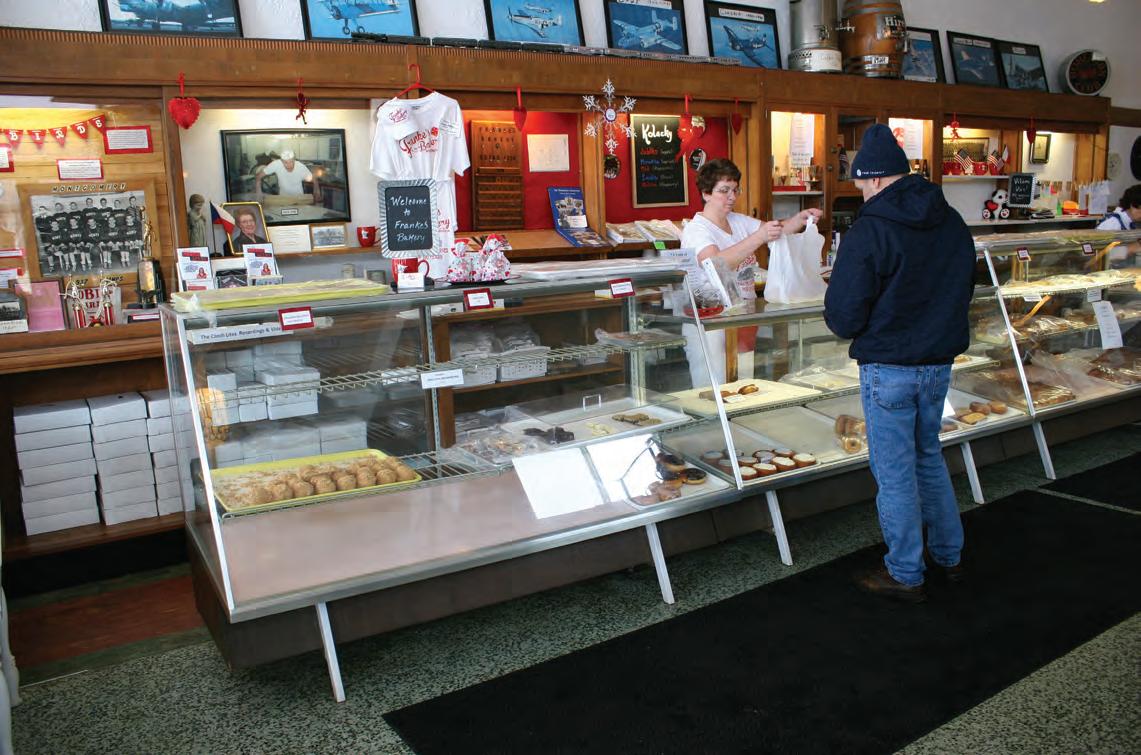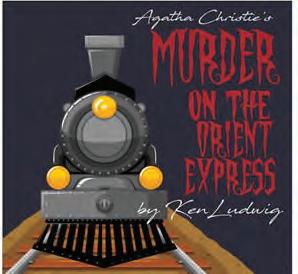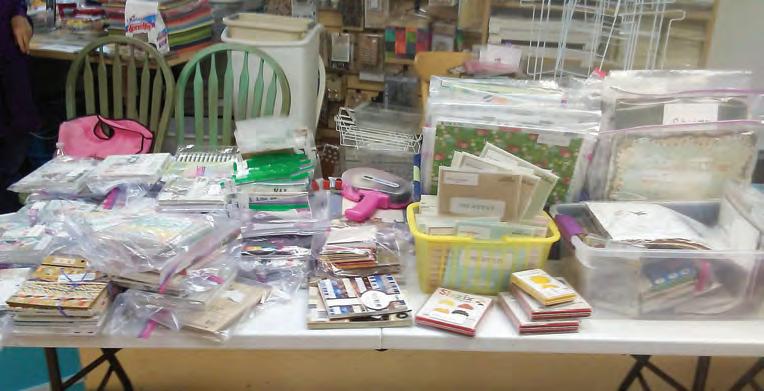
18 minute read
Let’s go Antiquing
from SCENE MARCH 2020
by Kate Noet
room. John is passionate about locating period-and-style-appropriate pieces for restoration projects, where the original lighting is missing. “It’s very rewarding helping people realize what they have – the historical importance, provenance and value of an item,” said John. Kruesel deals with a full range of antiques – jewelry and time pieces, glassware and china, historic documents and photographs, silver, toys, books, works of art and decorative accessories of all periods. Collecting fads come and go, but gold jewelry such as rings, lockets and necklaces, and sterling silver accessories such as cigarette cases, baby cups and candlesticks, are timeless gift choices for many clients. Kruesel currently has for sale a 19th century cigar store Indian, carved from a single log and polychrome painted. It is a piece from the estate of a collector who acquired it from the original store in the Pennsylvania Poconos. Kruesel speaks of his unique business. “We love history. When photography in the 1860s suddenly allowed the European world to see how the Sphinx and pyramids and ancient statuary actually looked, the result was a flood of Egyptian designs, real and imagined, in jewelry, furniture, china, even picture frames. Fifty years later, the widely-publicized discovery of King Tut’s tomb, led to a second craze for Egyptian and Middle Eastern themes and included Rudolph Valentino’s Sheikh movies.”
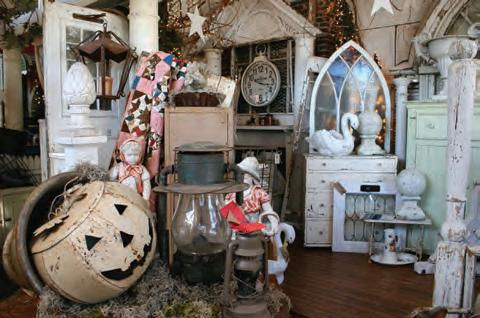
TRE ASURES UNDER SU GAR LOAF Brenda Jannsen and husband, Doug, are owners of Treasures Under Sugar Loaf, and they have been in business for five years. “We carry Sugar Loaf Scent candles, which are the best soy candles on the market. They are crafted locally, have a long burn time, have awesome scent throws, and catchy names, like Lick Me All Over, Monkey Farts, Lube Job and Mowing the Lawn. Candles make homes cozy and are terrific gifts for any occasion!” Brenda exclaimed. The Jannsens carry coins, knives, lamps, household items, small furniture, pictures, local history, glassware, and more. Treasures is also proud to carry hand-crafted creations from the local community. A general hot-selling category is primitives, including wood rolling pins, wood boxes and crates, wood utensils, metal tools, and cast-iron pans. “We have a large, jade pagoda, that is very detailed, right down to the hanging bells on each point. It stands majestically on a lacquered wood base; we have some intriguing weaponry, which always catches customers’ eyes. And what I personally find most intriguing are items from Bub’s Brewery. Bub’s Beer was brewed for over 100 years, right here in our current building,” explained Brenda. Treasures displays a combined inventory of antiques, collectibles, home décor and crafts, all intermingled attractively throughout the building. (1023 Sugar Loaf Road, Winona; 507-474-7030)

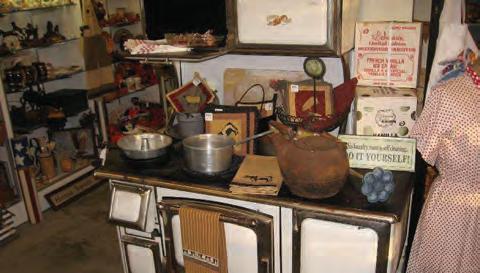
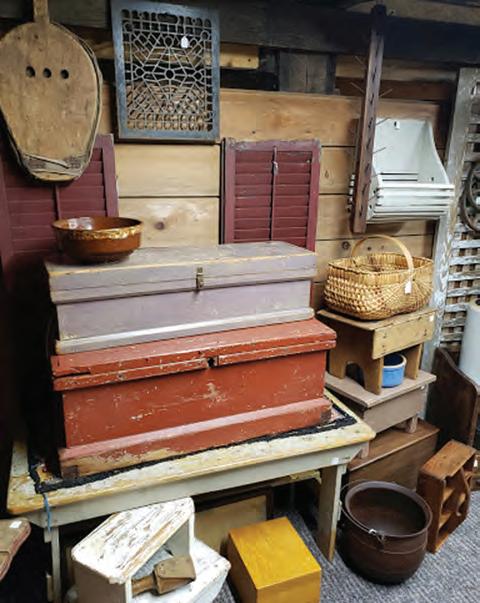
years ago they took a leap of faith, and opened their Rochester location; then relocated to Stewartville three years ago. “We have 25-plus dealers in our mall and they all have different, unique items. We do not specialize in any specific type of antiquities. We have items ranging from newer collectibles to items dating back to the 1800s” explained Chris. The Kujaths host a bi-annual flea market in the spring and fall, with indoor and outdoor spaces at the two-day event. OR VSM is open seven days a week. The store itself used to be a lumber yard, and most of the retail space was kept intact. They utilize the lumber storage area as their “barn”; where rustic and larger pieces are housed (currently the space features a horse-drawn sleigh). Old River Valley Antique Mall displays a diverse group of vendors with a wide variety of vintage items, collectibles, primitives, and antiques, in 7,000 square feet of retail space. 507- 533-0094; 204 South Main Street (Highway 63 South); Stewartville, M N; Monday through Saturday: 9:30 a.m. - 5:30 p.m. and Sunday: 12 noon - 5:30 p.m. Labor Day.
MS , MAC’S ANTIQUES S usie McConville’s Ms. Mac’s Antiques store, opened in Janesville in 2001. Some of her “must have” items include architectural elements – corbels, old doors/windows/pillars/spindles; drawer cabinets – anything with drawers for storage/crafters; old harvest/ farm tables; primitive/country cupboards with original paint. Susie has always preferred decorating her home with antique and vintage items, and her dream was to eventually own an antique store. “Only an antique dealer can truly appreciate the amount of time, energy, dedication and passion that it takes to be successful in this business,” remarked Susie. Ms. Mac’s style has evolved over the years – beginning with refinished oak/pine furniture, wicker pieces, old toys, tin items and enamel-ware; and transitioning to a focus on primitives – old, painted country cupboards, early quilts, garden accessories and vintage signs. Popular pieces include: early, old washtubs/stands; pails for flower pots, old scoops, etc. “We do offer some new gift-ware – i.e. candles, pillows, and holiday gift items for customers who may not necessarily be interested in antiques – but this is a minimal part of our inventory. Over the years, we have built a solid reputation in the antique community, for our integrity, honesty and quality of merchandise. The majority of our customer base comes from all over the state in addition to South Dakota, W iscon sin and Iowa,” explained McConville. (open most Thursdays thru Saturdays, from 10:30 a.m. to 4:30 p.m.; available by appointment for days/times outside of regular hours by calling (507) 317-2457 or messaging thru Facebook). Ms. Mac’s Antiques, 100 North Main Street, Janesville.
MANTOR VILLE SQUARE (antiques and collectibles) Ed and Barb Kuhlman are part owners of Mantorville Square (antiques and collectibles) in historic Mantorville. The Kuhlmans boast oodles of items, including sterling silver, estate jewelry, Red Wing crocks & jugs, Caprice, Fostoria, depression & carnival glass, furniture & primitives, Shaker “great wheel” spinning wheel, vintage clothing, paper ephemera, Ertl & other collectible farm machinery/ vehicles, original art, vintage books, sets of china, Pyrex, Corning ware, art glass, kitchen primitives, advertising collectibles, Shirley Temple, cast iron banks, and much more. “This wasn’t our first encounter in the antique business. We got into the business because we loved going to auctions and we love old things,” Barb Kuhlman explained. Mantorville Square carries a wide range of antiques and collectibles, as well as milk house candles, and seasonal/garden decor. The Square is open year-round, and it often features vendor discounts, especially during events sponsored by the Mantorville Restoration Association and the Mantorville Chamber of Commerce. The big event of the year is the two-day Marigold Days, which is always the weekend after Labor Day.
OLD RIVER VALLEY ANTIQUE MALL C hris and Erik Kujath own and operate the highly successful, BEST OF award-winning antique mall, located in Stewartville. The Kujaths carry a wide variety of antique, holiday-décor for every occasion; like ceramic Christmas trees, papier-Mache pumpkins, vintage blow molds, valentines, and plastic candy bunnies, which are always popular. Cast iron sells at a variety of price points and comes in many styles. There is Griswold, Lodge, Wagner, and other unmarked pieces throughout the store. Chris and Erik started off as dealers in other shops and participated in flea markets. Ten

WATER STREET ANTIQUES
Kathy Lapic, owner of Water Street Antiques, 240 Water St. in Jordan, MN, took over the business nearly four years ago, but it has been an antique store for over 25 years. “Besides the financial rewards, I am most pleased that our store is a recycling center, a museum, a trip down memory lane for older people, and an education center for the young folks, who are learning how the old ways worked,” explained Lapic. There are thirteen dealers within the entire venue. One dealer has a large collection of pocket watches and key-wind clocks, and there are two mid-century dealers. Another dealer specializes in early 1900’s antiques. “And I look for the odd and unusual pieces to bring to the store. Since about 60% of our customers are men, we try to stock a lot of hunting, fishing, tools, automotive, knives and beer memorabilia,” Lapic suggested. The store has a “Want Book” – where people can provide their names and phone numbers and their desired items. That provides the store dealers the opportunity to try and fulfill the customers’ requests. A couple of unique antiques in Kathy’s store are a firebrigade bucket from 1885 and a California Sheriff’s Riot Helmet from the 1960s. Water Street Antiques is a true antique store. Open seven days a week, it boasts an unusual mix of items. The premises are housed with very affable dealers who try to be competitive in the antique market, both in pricing and in inventory. SMS
W ho are you? There are many possibilities. You can answer with ethnicity, gender, social strata, or surname, mention your species, family origins, religion, or hobbies. So many things and yet, as in the new book “Becoming Eve” by Abby Chava Stein, only one answer really matters. Yisroel Avrom Ben Menachem Mendel was born on the 24th of T ishrei in the year 5752 – or , for those who are not UltraOrthodox Jews, the first of October, 1991. The sixth
child and firstborn son, Y isroel’ s birth was the cause of great jubilation: one main forebear was Baal Shem Tov, a holy leader and the founder of Hasidism. In their Brooklyn community, that made Yisroel a member of royalty. Almost from the moment of birth, the future was set: Y isroel would follow the same path laid out for the males of the family , starting with ritual circumcision and religious observances, then yeshiva to study the Torah and Jewish law, marriage at age 18, and hope for sons to continue the line. There was no alternative. The entire family lived like this, like “eighteenth-century Eastern Europeans,” and had done so for centuries. T he exception came when then-four-year-old Y isroel insisted on having always been a girl. Later, though other childish things were forgotten, those thoughts never were. They were constant, remembered, boxed up, ignored, or excused. Even when theological questions roared, when religious texts seemed to confirm Yisroel’s suspicions of girlhood, when sex – a subject no Ultra-Orthodox Jew was supposed to know about until days before marriage – made an all-boy yeshiva more bearable, questions of gender were suppressed. At 18, “matched” with and married to a woman who was nearly a stranger, Y isroel burned with envy that wearing a bridal gown would forever be denied. Naming their firstborn son was devastating. “ Oh, and gender?” says author Abby Chava Stein today. “It started punching me in the face.” Without a doubt, “Becoming Eve” may be one of the most fascinating books you’ll read this winter. Certainly, it’ll be one of the most unusual. Set in a community that is meant only for adherents, author Stein’s story is told in rich detail that lets readers imagine everyday life with restrictions that most of us would chafe under, and without the internet, blue jeans, fast food, or English. These day-to-day details are relayed in a matter-of-fact tone that makes the severity of the “laws” seem even more astounding because of the seeming scarcity of emotion associated in their telling. Stein’s lifelong question of gender almost seems secondary to those astonishments, but as the tale progresses, her demand for answers grows quietly in a way you almost won’t notice until it pounces on you. W hoosh, it’s a relief you never knew you were waiting for.
And yet, relief is fleeting: Stein leaves readers hanging by not including an up-to-date which could be frustrating in any other story, but this unusual book’s end still feels just right. For that, “Becoming Eve” is a most satisfyingly unsatisfying book, and you’ll love it no matter who you are.
Becoming Eve: My Journey from UltraOrthodox Rabbi to Transgender Woman by Abby Chava Stein, c.2019, Seal Press, $28.00 / $35.00 in
Three hundred sixty-five days. That’s the amount of time we all had last year: 52 weeks of 24/7, but your friend had a 2019 that seemed to last forever. He is, in fact, still struggling and you want to help but how? What can you say or do to get him through? Start by reading “Beneath the Surface” by Kristi Hugstad and tackle today first.
“I was a teenager once, too!” No doubt you’ve heard that from at least one adult in your lifetime and you can’ t argue with it. What you can say, though, is that things are different. Being a teen today is hard: with social media, smart phones, and inescapable peer pressure around, you and your friends might encounter problems that are too overwhelming to deal with alone and it might seem like nobody’s listening, which is scary. That’s when serious help might be needed – help from “the right person” – to make things better. First, though, know this: what’ s happening isn’t anybody’s fault. A depressed person didn’t ask to be like that, someone who’s bulimic didn’t look for it, nobody who’s addicted wants to be addicted – furthermore, bad things can happen to anyone at any time. And if you believe you’re depressed/addicted/bulimic because your brain doesn’t work right, well, it’s a fact that areas Beneath the Surface: A Teen’s Guide to Reaching Out When You or Your Friend is in Crisis by Kristi Hugstad
of the human brain mature at different times. The second thing to know is that you are not alone. If bullying or cyberbullying is an issue, say something! If you’re cutting, show someone. If it seems like the pain won’t ever stop, ask for help and don’t stop speaking or asking until you find that “right person.” Learn to recognize stress and know that even just a little anxiety can grow until you can’t deal anymore. Watch for addictive behavior , including addiction to electronics. Become educated about the mythology of teen suicide, know who’s at particular risk, self-assess now and then, and recognize the warning signs that scream for a professional. Finally , remember: there is absolutely zero shame in accepting therapy or help. As illustrated by the stor y of her husband’s suicide, author Kristi Hugstad shows how easy it is to miss a crisis brewing. So how can we best arm our teens and make them equipped to handle such unimaginable things?
The path your parents first set you on is not the path you ended up taking. Somewhere along the way, you veered to the left or stepped to the right. You found your own groove, made your own decisions, and made adjustments while you learned where you were going. And as in the new book “The Broken Road” by Peggy Wallace Kennedy (with Justice H. Mark Kennedy), it was essential to know where you came from. She never doubted that her Daddy loved her. Still, when Peggy Wallace Kennedy was growing up, her father was absent more than he was present, even when he was in the room: George Wallace’s political promise to himself as a young man consumed him until campaigning became an obsession. He was away for much of Kennedy’s early life, meeting prospective constituents and asking for votes.
After he lost the 1958 Alabama Governor’s seat to an opponent who was “racist to the heart,” the obsession grew and festered.
Before then, says Kennedy, when her father was a judge, he was known for fairness and equality in the courtroom but when W allace lost that election, something changed in his mind. He started telling The Broken Road: George Wallace and a Daughter’s Journey to Reconciliation by Peggy Wallace Kennedy with Justice H. Mark Kennedy
people that he was a segregationist, he began using words that were shocking, and his behavior attracted voters to his side. He all but abandoned his wife and family, and focused only on winning the next time. Kennedy says that once the W allaces were ensconced in the Governor’ s Mansion in 1962, she thought everything was fine until she learned of the violence happening throughout their state and, though she was just a child and somewhat shielded from her father’s actions by her strong, tenderhearted mother, she couldn’t believe her Daddy would allow that. After her mother’s death, however, when Wallace renewed his decision to run for President, Kennedy’ s eyes were opened and she wished she could stand for racial equality by standing up to him.
But by “the fall of 1968,” she says, “I was neither white nor black. The color of my skin was W allace.” Absolutely , “The Broken Road” is a book of a thousand emotions. Anger, disgust, outrage – of course, you may remember those.
Keep going: deep sadness rings this tale, but a
Y ou’ve got a tale to tell. E verybody does, but people believe that yours would sell. Write a book, they say, your story is interesting/funny/exciting. And so you start to imagine the crowds at your book signing. You think about the money you’ll make. You picture the life of a writer. You should read “Consider This” by Chuck Palahniuk before you go any further. L ong before he was an author of novels, Chuck Palahniuk was a truck assembly line
worker with a journalism degree, struggling to be a better writer through a series of expensive, ineffective workshops. Then he met Tom Spanbauer, who offered “less a class than a dialogue.” That, says Palahniuk, is what he hopes this book will be.
“If you’re dedicated to becoming an author, nothing I can say here will stop you,” Palahniuk cautions. “But if you’re not, nothing I can say will make you one.” If you were Palahniuk’ s student, though, he would tell you to pay attention to the “textures” in your characters’ conversations. Use textures as you would in normal conversation; they’ll help your readers know who said what, they’ll bridge conversational gaps, and they help indicate time passed. “ Establish… authority” to make your characters relatable. Offer real-world context; never, ever ignore fine details; and don’t worry about making people likable. Some of literature’s best-loved characters were despicable.
If you were Palahniuk’ s student, he’d tell you to “plant a gun” and an object that quietly returns again and again. He’d instruct you to surprise your readers and raise tension, both correctly, and to avoid ping-pong conversations. Y ou’d start to listen to other people’ s stories because that’s where your novel lies. You’d know how to rescue a boring character and how to write dialogue that sounds authentic. And if Palahniuk were your teacher , you’d learn this: “Don’t overthink your creative process.”
Great writers are not born that way. They are molded from a mixture of sweat, rejection, odd hours, tiny pieces of notepaper, antacids, and books like “Consider T his.” Your readers have a short list of things they hate in a novel, and author Chuck Palahniuk shows you how not to do those things when writing your future bestseller .
“Beneath the Surface” could be a good start. Beginning with honesty and careful words about that which can seem insurmountable, and always keeping one finger on suicide as the hub, Hugstad lists possible warning signs related to the most common, most dangerous actions. That info’s backed up by short, bullet-pointed chapters that are easily browsed but packed tight with takeaways, which is a good thing for busy teens. Another value: the advice on advocating for self or friends is straightforward and unembellished. This is one of those books you hope you never need. It’s good to have around in these tumultuous times, though, and it’s sure to be a conversation starter. For teens, families, teachers, and allies, “Beneath the S urface” could be just the thing this year. Beneath the Sur face: A Teen’s Guide to Reaching Out When You or Your Friend is in Crisis by Kristi Hugstad, c.2019, New W orld Library, $19.95 / $23.95 in Canada, 184 pages.
sense of satisfaction may be found, too, as pieces of a 50-plus-year-old puzzle fall into place. Also in author Peggy Wallace’s hands, the story of her mother is told with steely inspiration, while other passages hold a tinge of droll W ell-Bless- Y our-Heart zingers that are delightfully tucked in. Mostly, though, this book seems to be about teasing apart the years, trying to understand why and how what happened, happened, and reconciling what was with what is. It’s a child’s-eye view of history with an adult’s careful perspective, finalized as Kennedy writes of spiritual generosity and the forgiveness her father received toward the end of his life, and the tender friendships she has with those he hurt. L ove, politics, the tumultuous ‘60s, current events, it’s all in this can’t-miss biography. “The Broken Road” is paved with grace.
The Broken Road: George Wallace and a Daughter’s Journey to Reconciliation by Peggy Wallace Kennedy with Justice H. Mark Kennedy, c.2019, Bloomsbury, $28.00 / $38.00 in Canada, 292 pages.
Replacing bad behavior with good is part of this book, including advice that makes so much sense that you wonder why you never thought of it before. (Hint: you didn’t because you’re not his student). On that note, Palahniuk will delight you as he instructs, by subtly using his own advice scattered throughout this book amid stories of his struggle to become a novelist and tales of booksignings that were held on his behalf. There are shout-outs to other authors that serve as a kind of reading list for prospective writers, and yes, you’ll find a few headscratchers that may not make sense until you’re there. W riters who are readers will enjoy this book for its anecdotes. Readers who are writers will love it for the chance to watch a master in action. If you are both, “Consider This” tells the tale. Consider This: Moments in My W riting Life After Which Everything Was Different by Chuck Palahniuk, c.2020, Grand Central Publishing, $27.00 / $34.00 in Canada, 256 pages.



